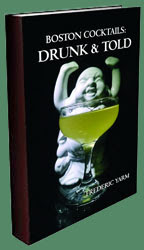 My Friday morning talk was on eggs in bars and cocktails hosted by Nathan O'Neill of the Nomad Hotel, Nick Wright of Suffolk Arms, and Tim Herlihy of Tullamore Dew. In 2010, I attended a talk on eggs at Tales of the Cocktail called "The Eggpire Strikes Back," and I was curious what a new crew of speakers would say this time around. Please read that post as a supplement to this one.
My Friday morning talk was on eggs in bars and cocktails hosted by Nathan O'Neill of the Nomad Hotel, Nick Wright of Suffolk Arms, and Tim Herlihy of Tullamore Dew. In 2010, I attended a talk on eggs at Tales of the Cocktail called "The Eggpire Strikes Back," and I was curious what a new crew of speakers would say this time around. Please read that post as a supplement to this one.A lot of insight into egg production came by Tim's family starting an egg farm in 1978 that began with 5,000 hens and is now around 80,000 hens which produce 1.5 million eggs each year. Here are some random egg facts:
• A hen's earlobes match up to its egg color (save for pink and blue egg layers). There is no nutritional difference in regards to egg shell color.
• Eggs are great sources of low calorie, high protein nutrition with 6 grams protein, 12 vitamins and minerals, and only 63 calories.
• Yolk color and egg flavor comes from the feed; welfare conditions do not effect the taste.
• Double yolks come from young hens, often 16-20 weeks old.
• Yolkless eggs were considered the tool of the Devil in Medieval times and were feared to hatch a serpent.
• As hens grow older, they produce larger eggs.
• An average hen can produce 259 eggs per year.
In terms of egg usage in cocktails, the whites are useful for foam and froth to impart a silky mouth texture and can calm down a strong acid or alcohol flavor; they do not impart any flavor. Yolks donate a richness and noggy flavor to drinks, and they help to emulsify ingredients.
Possets were rather old style of drink that started out as a peasant's drink before becoming more upperclass. The drink was heated and poured into a vessel called a posset akin to a tea pot with two handles. The Red Eye, the beer, tomato juice, and egg concoction that is famous for appearing in the movie Cocktail, can be traced back to this drink. One bar guest of mine described the Red Eye as a way to get around certain states' low ABV beer restrictions on Sundays since it was a mixed drink and not a beer at that point.
While Sours can be made with or without eggs, the original recipes including Jerry Thomas' did not include them. It was not until the early 1900s that egg-containing Sour recipes appeared. Even the Pisco Sour existed without egg white until the 1920s when it gained its now essential component. Fizzes, however, have had eggs in the recipes well before Sours, even though they are Sours with a carbonated component. Fizzes were morning bracers and perhaps eggs and breakfast assisted this connection. The Ramos Gin Fizz, for example, was born in 1888 at the Imperial Cabinet Saloon by Henry C. Ramos well before Sours were reported to include egg whites.
Flips contain whole eggs and can contain cream, but unlike Nogs, they do not require dairy. The style started in England during the 1600s with beer, rum, sugar, and a hot poker before transitioning to the frothy egg drink in later centuries. Nogs use yolk or whole egg plus dairy (milk and/or cream). The name perhaps stems to 1775 when Grog was served in Noggin glasses. Tom & Jerry dates back to the 1820s and not to Jerry Thomas who was not yet bartending at the time.
Tips for working with eggs:
• A squeeze bottle of egg white or whiskey egg is safe, but storage is risky for cross contamination is very fast.
• Do not break your eggs on the exact same spot in the bar every time to avoid contamination.
• Do not wash your eggs since it removes a protective mineral oil coating.
• The fresher, the better. Do not store eggs near ingredients giving off odors since eggs will absorb these notes.
• The wet dog smell in eggs can put people off, but it does not mean the egg is bad. It is the effect of water working its way through the egg. Infusing the egg with aromas (like truffle oil) can fix this. I would add that garnishes like citrus oil or nutmeg can mask this as well.
• Salmonella exists in 1 in 20,000 to 40,000 eggs. Make sure that the eggs you use have no cracks in the shell and have no odors when cracked open.
In terms of shaking with eggs, performing a dry shake without ice will emulsify the egg proteins and add texture and froth. This change to add aeration occurs best at higher temperatures. The dry shake can be performed twice; opening the tins between rounds will get more air in. The next shake, or wet shake, is performed with ice to chill and waterize the drink. The reverse dry shake was also discussed to get a thicker head.
Finally, the bar egg was discussed as a dying bar tradition. It was born in France as a way to get rid of surplus eggs and often served with salt, pepper, and Tabasco for seasoning. It might have also stemmed from certain legislation that required that food to be served at bars, and this was a great work-around when the bar had no kitchen. Moreover, bars used to serve free lunch towards the end of the first drink to entice the patron to get a second drink, and the bar egg was a cheap way to do this.
 The 2017 collection of 855 drink recipes, bartender tributes, and essays on hospitality from CocktailVirgin's Frederic Yarm. Available at
The 2017 collection of 855 drink recipes, bartender tributes, and essays on hospitality from CocktailVirgin's Frederic Yarm. Available at  The 2012 collection of 505 drink recipes, techniques, and Boston bar recommendations from Frederic Yarm. Available at
The 2012 collection of 505 drink recipes, techniques, and Boston bar recommendations from Frederic Yarm. Available at 




No comments:
Post a Comment